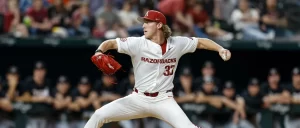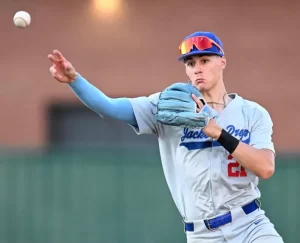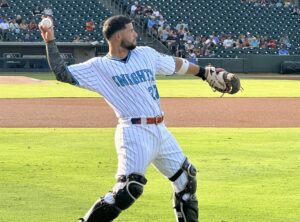Draft Preview: Jon Harris
Jon Harris
School: Missouri State
Position: RHSP
Height/Weight: 6‘4”, 190
B/T: R/R
D.O.B.: 10/15/1993
Previously Drafted: 2012 – Rd 33 (1015) by Toronto Blue Jays
Scouting Reports:
High School:
Harris had enough talent in high school to get some attention, pitching for Hazelwood Central in Florrisant, MO. But he lacked the stamina to maintain velocity, with his fastball starting 88-90 before quickly falling to the mid-80s in his starts. Note that his high school draft profile listed him at the same 6’4″, but weighing 160 pounds – he is now listed thirty pounds heavier, three years later. His curveball was noted as having high potential at the time. He was also a good enough hitter to be considered a potential two-way player at the college level, but that didn’t materialize.
College:
Harris has a prototypically ideal pitching frame, with a strong lower body. His 6’4″ frame still fairly lean and capable of adding more mass to the existing 190 pounds. Delivery consistency and body control are noted as positives in multiple scouting reports. The native Missourian pitches deep into games and now maintains velocity consistently, showing excellent stamina.
Harris’ pitch repertoire features a fastball that sits low-90s and touches mid-90s, with sink from his tall release point. His curveball and slider both flash plus with good depth and some tilt on the curve, and his change-up is a developing pitch that has shown potential to be above average. As you’ll see below, projections for Harris’ ultimate draft slot vary significantly, though all show 1st round ratings.
MLB.com shows Harris as the 10th best prospect in the draft on their latest write-up, and gives Harris an MLB comp of Ross Detwiler. Cash Kruth’s profile on the site says: “His curveball, slider and changeup are all plus pitches at times. Harris has power and depth on his breaking balls, and he has made huge strides with his changeup and trusts it more than before. He also has improved his command and is doing a better job of pitching inside with his fastball.”
Baseball America has Harris at 25th on their latest draft prospect list, and has this to say: “[his fastball] sits at 91-93 mph all day and he will touch 95. Harris mixes in a pair of breaking balls, a 12-to-6 curveball that flashes plus and a solid-average slider that he is able to throw for strikes. His changeup is a potentially average pitch as well, and some scouts have seen each secondary pitch flash plus.”
Andrew Krause of Fangraphs wrote a detailed profile, ending with this conclusion: “Harris may not have the blazing fastball or devastating, GIF-friendly breaking ball that demands a lot of attention, but he does offer clubs with a relatively-polished, high-floor option. If he continues to pound the strike zone and demonstrate the same above-average ability to command his four pitch mix, Harris has a good shot to be a 3rd/4th starter at maturity.”
Scouting Grades:
Note: these grades are my summations based on all readily available scouting information from sources such as Baseball America, MLB.com and Fangraphs (Present/Future, 20-80 scale):
Fastball: 50/60
Curve: 50/55
Slider 45/55
Change: 45/55
Command: 55/60
Overall: 55 FV
Prospect Overview and Future Outlook:
Jon Harris is more likely to be picked in the 10-20 range or possibly later overall based on projected value, which would make him a slight overdraft at 8th overall. But the White Sox have been tied to him in some write-ups, and he does fit the mold of a pitcher likely close to the majors with a “low floor” that the team might see helping the big club sooner rather than later.
Statistically, after a “breakout” showing in the Cape Cod League last summer, Harris has carried the success into his current season at Missouri State. In 2014, the numbers looked like this: 3.16 ERA, .226 BAA, 28 BB and 66 K in 79.2 innings. Now in 2015: 1.85 ERA, .189 BAA, 35 BB, 113 K in 97.1 innings. He’s also allowed just one home run this season, with that downhill fastball helping prevent the long fly ball.
There are really two ways to look at Harris. On the one hand, he is a relatively polished starter with advanced command for his age but relatively low ceiling. Note that he doesn’t have any one or two stand-out pitches, and even the 60 FV on the fastball may be ambitious. This screams of high floor, but quicker to the majors talent that could be a contributor as soon as 2016. Some White Sox fans may be having flashbacks to the likes of Lance Broadway and Kyle McCulloch, though Harris’ projections are stronger than those profiles had. For some, this would be a disappointing choice.
On the other hand, there are plenty of reasons to believe there is still significant projection available here. He’s got the frame and history to indicate he likely can add more strength, and his offspeed pitches have all improved noticeably in the past year. At 21 years old (turns 22 in October) he’s not going to have high schooler-level projection, but he’s not a 23-year old fifth year senior either. There is room to grow.
Then there is this – advanced command and delivery consistency are always chased but often never found, and Harris already has both. Some of the same qualities that give him that “high floor” tag that sometimes sounds like a back-handed compliment, also give him value in time-to-market and likelihood of sticking as a starter. Having good command of four pitches that project as at least major league average if not better, all four flashing plus at least at times, gives him a very solid base to start from.
Harris is likely not first, or even second or third, on the White Sox wish list. He’s a fall-back option, but one that some see having an ultimate impact higher than many of his first round peers. He’ll almost assuredly be available at #8.
Want to know right away when we publish a new article? Type your email address in the box and click the “create subscription” button. Our list is completely spam free, and you can opt out at any time.







